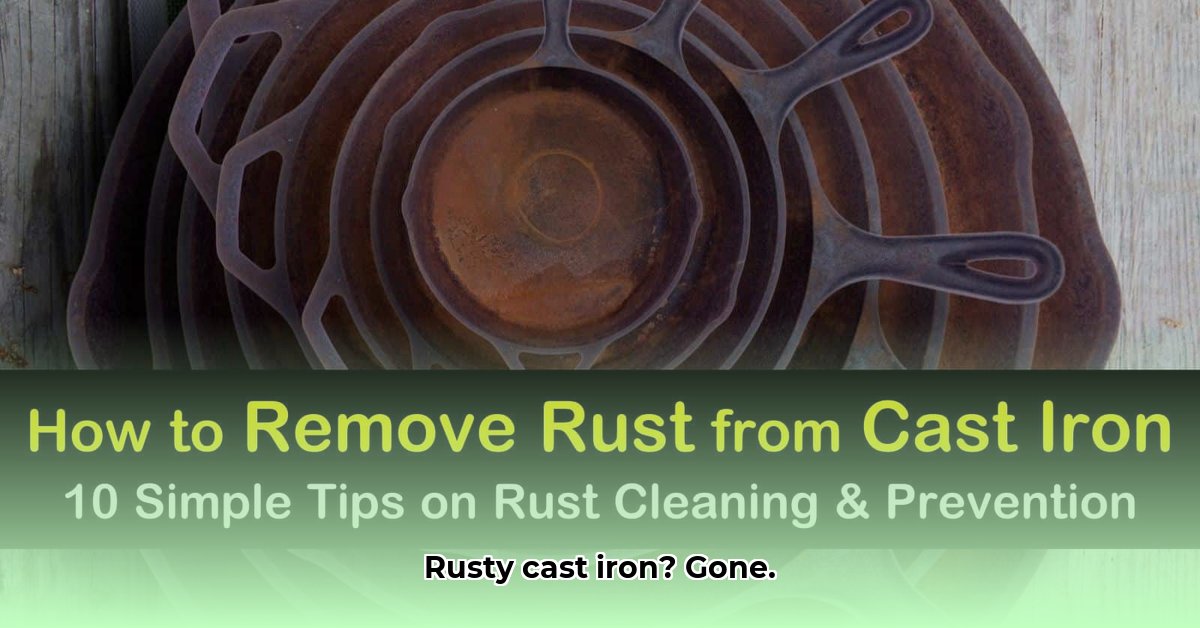Cast iron’s resilience and ability to develop a naturally non-stick surface makes it a kitchen favorite. However, even the most well-loved cast iron can fall victim to rust. Don’t worry, this guide provides a comprehensive approach to banishing rust and restoring your cast iron to its prime. Whether it’s a light dusting or a thick coat, we’ll cover everything from simple salt scrubs to more involved electrolysis, plus essential re-seasoning and prevention tips.
Reviving Your Cast Iron: Rust Removal Methods
Cast iron rusts when iron, oxygen, and moisture interact. The resulting iron oxide can compromise the seasoning and cooking performance. Luckily, several methods can tackle this, each suited to different rust levels.
Light Rust Removal: Quick Fixes for Surface Rust
For light, superficial rust, a simple scrub is often sufficient.
- The Salt Scrub: Sprinkle coarse kosher salt liberally over the rusty areas. The coarse salt acts as a gentle abrasive.
- Potato Power: Halve a potato and use the cut side to scrub the salted area. The potato’s moisture and starch help lift the rust. While some suggest the potato’s acidity aids the process, this isn’t definitively proven.
- Rinse and Dry: Rinse the pan thoroughly with warm water, then dry it completely and immediately. This prevents further rust formation. A towel dry followed by a few minutes on a warm burner is recommended.
Alternatively, a baking soda paste can be used:
- Make a Paste: Combine baking soda with water to form a thick paste.
- Apply and Wait: Apply the paste to the rust and let it sit for 15-20 minutes.
- Scrub and Rinse: Scrub the area with a non-abrasive sponge or fine steel wool (#0000), then rinse and dry thoroughly.
Moderate Rust Removal: Vinegar Soak for Deeper Cleaning
When the rust is more persistent, a vinegar soak is likely needed.
- Vinegar Solution: Mix equal parts white vinegar and water in a container large enough to submerge the rusty item. White vinegar’s mild acidity helps dissolve rust.
- Soak and Monitor: Submerge the cast iron and check its progress every 30 minutes. Soaking times typically range from 2 to 6 hours, but avoid exceeding 8 hours.
- Clean and Dry: Remove the cast iron, wash with warm, soapy water (mild dish soap is best), and dry thoroughly. A final warm-up in a 200°F oven ensures complete dryness.
Heavy Rust Removal: Electrolysis and Other Aggressive Approaches
For heavy, caked-on rust, more intensive methods are required.
- Initial Scrub: Remove loose rust flakes using steel wool, a stiff brush, or a metal scraper.
- Baking Soda Scrutiny: If needed, clean the pan with mild dish soap and water. Then, make a baking soda paste, apply, let sit, and scrub vigorously. Repeat if necessary.
- Electrolysis (Optional): For severe rust, electrolysis is highly effective. This process uses a low-voltage electrical current to remove rust. Numerous online tutorials detail the process, which involves a battery charger, baking soda solution, and other components. Research thoroughly before proceeding.
- Commercial Rust Removers (Use with Caution): Commercial rust removers are available but may contain harsh chemicals. Exercise caution, follow product instructions precisely, and use appropriate safety gear. Some studies suggest these removers can impact the underlying metal, so exercise caution.
- Rinse and Dry: After any of these methods, rinse and dry the cast iron thoroughly.
Re-Seasoning: Building the Protective Layer
Re-seasoning is essential for restoring the non-stick surface and protecting against future rust.
- Oil Application: Preheat your oven to 450°F (232°C). Apply a very thin layer of cooking oil (vegetable, canola, or flaxseed are good choices) to the entire pan, inside and out. Excess oil can create a sticky residue.
- Oven Baking: Place the oiled pan upside down in the preheated oven and bake for 1 hour. This polymerizes the oil, creating a hard, protective layer.
- Cooling: Turn off the oven and let the pan cool completely inside. Slow cooling helps prevent cracks in the seasoning.
Rust Prevention: Keeping Your Cast Iron in Top Shape
Preventing rust is easier than removing it. Implement these strategies:
- Dry Immediately: Always dry your cast iron thoroughly after washing.
- Avoid Soaking: Minimize soaking time, opting instead for quick washes with warm water and a scrub brush.
- Salt for Daily Cleaning: Use coarse salt and hot water for everyday cleaning. Use soap sparingly.
- Dry Storage: Store cast iron in a dry place.
- Regular Re-Seasoning: Re-season every few months or as needed.
- Mind the Acid: Limit cooking highly acidic foods for extended periods.
Method Comparison: A Quick Guide
| Method | Rust Level | Time Required | Materials Needed |
|---|---|---|---|
| Salt Scrub | Light | Short | Coarse salt, potato |
| Baking Soda Paste | Light | Short-Medium | Baking soda, water, steel wool/non-abrasive sponge/cloth |
| Vinegar Soak | Moderate-Heavy | Medium | White vinegar, water |
| Baking Soda Paste & Vinegar Soak | Heavy | Medium-Long | Baking soda, water, white vinegar |
| Method | Rust Level | Time Required | Materials Needed |
|---|---|---|---|
| Electrolysis | Heavy | Long | Battery charger, baking soda, etc. (see tutorial) |
| Commercial Rust Remover | Heavy | Varies | Commercial rust remover product, safety gear |
| Steel Wool/Stiff Brush/Scraper | Heavy | Medium-Long | Steel wool, brush, or scraper |
Troubleshooting
- Stubborn Rust: Repeat the cleaning process or try a more aggressive method like electrolysis.
- Flaking Seasoning: Clean the pan thoroughly and re-season.
- Sticky Seasoning: Likely too much oil was used. Strip the seasoning and re-season with a thinner coat.
FAQ
- Can I use abrasive cleaners on my cast iron? Avoid abrasive cleaners, as they can damage the seasoning.
- Why is my seasoning flaking? This can happen due to several factors, including improper seasoning application, cooking highly acidic foods, or aggressive cleaning. Re-seasoning is the solution.
- How often should I re-season? Re-season every few months or whenever food starts sticking.
With proper care and these techniques, your cast iron can provide years of reliable cooking enjoyment.
- How Much Do Wellness Programs Cost Businesses To Offer? - December 16, 2025
- Wellness Fair Ideas for Work to Boost Employee Wellbeing - December 15, 2025
- Affordable Employee Wellness Fair Ideas for Any Budget - December 14, 2025
















